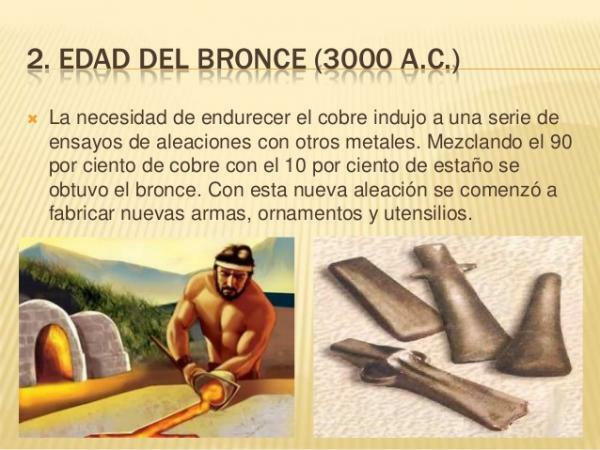METAL AGE: Copper, Bronze and Iron age

The Prehistory of Europe and Asia it tends to be divided into two large groups of technology, being different due to the number of advances they entailed. The second of the technological groups of Prehistory, being the one after the Stone Age, is the Metal Age, in which men learned to using and handling metals achieving, thanks to this, an evolution in all areas. To talk about this important period, in this lesson from a Teacher we offer you a Metal Age summary commenting, one by one, the different periods.
Index
- Copper Age, the first period of the Metals Age
- Bronze Age
- Iron age
Copper Age, the first period of the Metal Age.
We begin this summary of the Age of Metals talking about the first of the stages. Known as Chalcolithic or Eneolithic, It is the first period of the Metal Age, being a stage in which man began to use copper as the most relevant material of the time. This stage is located between the years 5000 a. C. and 1800 a. C.
The use of copper went through different phases, while
humans learned to use it more or less or created techniques for their manipulation or use. At first, they used copper in a primitive way, since they did not know how to melt it, although Over time they were able to improve and mix it with other minerals to improve its use.In these times, humans used techniques such as hammering or cold beating that allowed them to mold the material to create products of different kinds, being the only way they had to use the copper before learning smelting and metallurgy, after which they mixed it with materials such as gold or arsenic.
For many historians, the Copper Age was a period of transition in which they stopped depend on stoneBut the handling of metals was not yet effective enough to depend on the materials made by them. The reason copper was the first material to be used is that it was the most easily removable.
Characteristics of the Copper Age
To better understand the Copper Age we should talk about their main featuresThus, we can understand the great peculiarities of this stage in the history of humanity. The main elements of the Copper Age are the following:
- The copper happened to be the most important material, occupying the role that until that moment had the stone.
- Populations increased in size, the first examples of civilizations of humanity being born and some societies being born.
- They began to create walls and defenses of cities.
- The tribes they began to keep great differences, cultures being born for it.
- The use of copper improved the tools for agriculture and livestock.
- The megaliths as a way of respecting the deceased.
- It is thought that the social hierarchy, depending on different elements that we do not understand yet.
- The metallurgy, mixing copper with other minerals.
- Increased the class of animals used in the cattle raising, these being better for different elements.
Bronze Age.
The Bronze Age is the period in which the use began and bronze manipulation, thanks to humans discovering the mixture of copper and tin thanks to advances in metallurgy.
The dates that are usually used to establish the beginning of this epoch are among the years 3000 a. C. and 1500 a. C. Much depending on the area of the world that we talk about when setting an arrival of this material. Although the division of the period into three great stages, being the first of the Old Bronze between the years 1500 a. C. and 1200 a. C. that of the Middle Bronze Age between 1200 BC. C. and 1000 a. C and that of the Final Bronze between 1000 a. C. and 900 a. C.
An example of the importance of the arrival of bronze to the world was the creation of bronze weapons in the European peoples, causing the Achaeans to defeat the Cretan civilization, changing the European and Greek landscape forever.
Bronze Age Characteristics
To continue this summary of the Metal Age we must talk about the main features of this very important period, the main elements of this time being the following:
- The first civilizations and cultures with greater power and predominance of large urban centers.
- Religion, military life and slavery become key elements of the social differentiation.
- Nomadic life disappears, moving to a totally sedentary life.
- Forms are born language and writing primitives that allow minimal communication.
- It goes from cave life to house creation with wood and clay.
- All activities improved with the appearance of bronze, serving to technological improvements in all sections.
- The new ones transportation and trade in bronze these economic systems improved.

Iron Age.
To conclude this summary of the Metal Age, we must talk about the last stage of this period, being known as Iron age. This period characterized by appearance of iron is key to the history of humanity, since it led to the end of prehistory and the beginning of the Old age.
The appearance of iron took place between 800 a. C. and the beginning of classical civilizations, this element being much more important and effective than the rest of the minerals used so far, and therefore being key to the end of the Prehistory.
Characteristics of the Iron Age
The main characteristics that make the Iron Age such an important time in the panorama historical, and that allows us to understand how relevant it was for the passage from Prehistory to history are the following:
- Iron was much more common than previous materials, causing increase production of all creations.
- The iron served to create much more powerful weapons and numerous, causing iron peoples to be more dangerous in combat.
- The advances in agriculture With iron shovels or plow points, it allowed to work soils previously impossible and to achieve greater production in crops.
- The greater free time for the greater ease of work allows clothing and jewelry creation, which serve to increase the trade of the time.
- All advances allow the creation of more complex societies and therefore an increase in population.

If you want to read more articles similar to Metal Age: summary, we recommend that you enter our category of Story.
Bibliography
- Bosch-Gimpera, P. (1954). The Bronze Age of the Iberian Peninsula. Spanish Archive of Archeology, 27 (89), 45.
- Fabié, A. M. (1897). The age of copper.
- Coetzee, J. M. (2013). The iron age.



